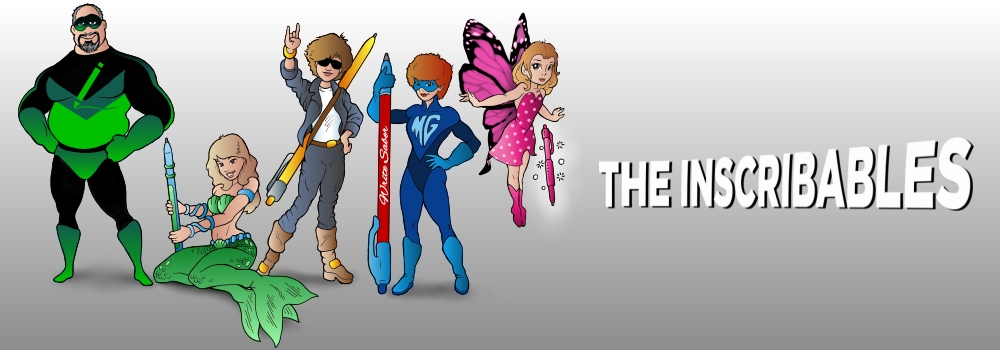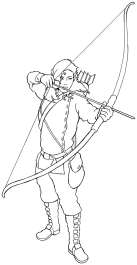

Just a few days ago I had someone say it to me again—"I can't even draw a stick person". If you've ever made a similar comment, I challenge you to see if it's true. Are you unable to draw? Let's find out.
If you're interested in discovering if you have the ability to develop drawing skills, I've put together a little exercise for you to do. I won't call it a simple exercise because it'll take some work and will probably require you to spend a few hours doing. But—when you're done—you'll have a better idea of how much inner artist is hiding in you. You might even find yourself inspired to learn more.
I borrowed this section from my book The How-To Book for Artists Who Can't Draw. I've modified it a bit and removed a few steps because we're not really trying to teach you to draw, but to see if you can draw.
First, click on the thumbnail of the Elvin Archer here (to the right) to see the larger image. You should be able to open and save the image. Either right click on the thumbnail and—when the menu pops up—click on "Save target As..." or left click on the thumbnail to open the larger image, right click on the image and choose "Save picture as...". You might as well do the other two thumbnails (save the other two images) while you're at it—you'll need all three images for this exercise.
Print out all three of the images. One should be just the Archer. The next will be two grids—one with the archer and the other with parts of the picture removed. The third will have the same grids; only the second grid is empty.
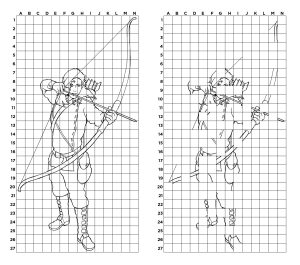
Using tracing paper (or tracing vellum), trace the picture of the archer. You may wish to tape the picture to the tracing paper to keep it from moving around. Take your time and do the best you can. It doesn't have to be perfect, but it does have to be your best. When you're finished, separate the picture from the tracing and see how you've done. Trace the picture several more times (at least two more). Compare your last tracing to the first. They may be the same—you may already be improving.
Now, using the two grids on the left (one with the archer and the other with parts of the archer) try copying the picture. We've all played games where you use letters and numbers to find coordinates ("A-1, G-17, etc.)—well, this is just like that. Locate the place on the second grid that matches the first grid and finish out the picture I've started for you. Feel free to do this several times.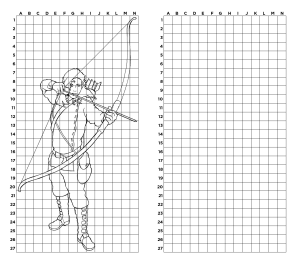
Finally, do exactly what you did with the previous grid-set using the second grid-set (on the right). This doesn't give you anything to start from, but it should work exactly the same for you.
How did you do? Even if you struggled but were able to do a fair job of copying the picture— and you're willing to put the time into it—you may wish to find a nice beginners book on illustrating and see what you're capable of.
Good luck. I have faith in you.
Mr. Illustrator
Being Creative is as Awesome as Surfing on Dolphins
|

I'm going to swim out to the deep end and guess you're a creative person. You're reading this so you must like to draw or write (and read!) Or a mix of those things. It seems as if creative people dabble in all sorts of crafty endeavors. And that is awesome. As awesome as surfing on dolphins.
Anyone can be creative. Yup, anyone. The hard part is knowing that fact and training your brain. All your fun hobbies are like strength-training when you stumble upon the thing that makes your heart sing like a choir of sirens.
I've always been a creative person. In elementary school, I wanted to write. My first book was about a purple monster that I wrote to help my little sister learn to read. For a short time, I was a journalist who handed out newsletters at family functions (though I just covered softball games and listed what our Labrador had eaten that week). Then I got into sculpting—my sister and I would sneak clay from our mom who is a potter, and we'd make fairy tea sets that we'd paint with glittery nail polish once the clay hardened.
In middle school, I'd carry around a notebook and colored pencils everywhere. I wasn't good at drawing but I liked it, something to do quietly after I finished my assignments. I tried bead-looming. Really hard. One birthday, I received an Easy Bake Oven, but it was for bead-making instead of cupcakes. Perfect for me.
In high school, my best friend and I would pass a journal back and forth between classes, writing horribly angst-y poems about boys and how unfair life was. Fashion design caught my interest and I would take apart thrift store items and hand-stitch them into something new and—perhaps—cool. I got into scrapbooking and spent hours on layouts and patterned paper selections. My fingertips bled playing the guitar so I put it down. I can't carry a tune in a chum bucket anyway.
In college, I made jewelry. Then I got into photography. My roommate and I painted canvases so our apartment would have art on the walls.
All these hobbies were so much fun, but I didn't realize until I had my daughter and became a stay-at-home mom that my brain had been training for something great. Like Great White Shark great. I started writing again. And just this month, I have a poem published in Babybug, the award-winning children's literary magazine. My daughter, now five, is learning to read and she can see my words. Just like decades ago when I wrote the Purple Monster Book to teach my sister how to read.
Being in touch with your creative side is huge. Like Giant Squid huge. And I want to know about all the fun, creative things you do! Replying here (my Facebook page) gets you to my secret underwater grotto much faster than a message-in-a-bottle, just so you know.
Saltwater Scribe
Common Issues I See When Editing
 I know I said not to worry about mistakes in your first draft, but here are some guidelines you can use when going back through your manuscript to polish it until it gleams. Some of these are errors I saw most often when I was the senior editor for Champagne Books, but some are just things that really, really bug me. Trust me, if you have any aspirations of getting your work published, you don't want to bug an editor!
I know I said not to worry about mistakes in your first draft, but here are some guidelines you can use when going back through your manuscript to polish it until it gleams. Some of these are errors I saw most often when I was the senior editor for Champagne Books, but some are just things that really, really bug me. Trust me, if you have any aspirations of getting your work published, you don't want to bug an editor!
** Elliptical danglers: (Two kinds)
1) Danglers attached to the wrong noun. –Ex. “Strolling along the trail, Mt. Rushmore came into view.” The way this sentence is written, Mt. Rushmore was out taking a stroll! It should read, “As I was strolling along the trail, Mt. Rushmore came into view.”
Another Ex. “Fat and lazy, our vet says our cat needs more exercise.” Is the vet fat and lazy? The sentence should read: “Fat and lazy, our cat needs more exercise according to the vet.” Even better would be: “The vet says our cat needs more exercise because she's fat and lazy.”
2) Danglers that are attached to the right noun but are missing a preposition in order to make sense. – Ex. “Walking to the couch, he sat down.” One can't sit on the couch while walking to it. After must be added to the opening phrase for it to be possible. However, it is possible to do some things simultaneously, so a sentence like “Walking to the kitchen, he wondered what he wanted to eat.”
** lightening / lightning – The first one means to lighten, as in color or weight; the second is the accompaniment for thunder.
** peaked / peeked / piqued – Mountains are peaked. A child might exclaim, “No fair! You peeked!” One's interest is piqued.
** anxious / eager – Anxious applies only when anxiety is involved in the wait for something—if the person waiting is afraid of what will happen or otherwise worried about it. Eager should be used for all other kinds of anticipation. Also, anxious is followed by about or for and eager is followed by to.
** blond / blonde – The first is the masculine spelling; the second is feminine.
** fiancé / fiancée – Same as above.
** fewer / less — fewer is for things you can count and less is for things you can't count.
** effect / affect — Affect is a verb, and effect is (usually) a noun. To affect something is to change or influence it, and an effect is something that happens due to a cause.
(The rare exception is when effect is used as a verb to mean “adopt or bring about,” as in “to effect a change.”)
** Despite what Alanis Morissette thinks, irony does not mean unfortunate events or coincidences. If Alanis had sung, "Mr. Play-It-Safe was afraid to fly. So he took a train, it derailed and he died" she would have been closer to irony. But a better example is when some know-it-all rudely corrects your grammar or spelling in a Facebook post then makes a mistake in their comment. Or when somebody writes I HATE GRAFFITI on a bathroom wall.
** Shaking or nodding heads – It's not necessary to add yes or no. You can't shake your head yes nor nod your head no. In fact, when nodding, you can leave out the head altogether. All that's needed is “She nodded.” As we're admonished in The Elements of Style, eliminate unnecessary words.
** poured / pored – The first is something liquids do; the second means to look over or examine visually.
** Names that end with the letter “s” (except historical or Biblical names such as Jesus or Ramses) are made possessive by adding an apostrophe plus “s” Ex. “James's eyes were an angry blue.” or “Jess's nose was out of joint.” And you never, EVER make a word that doesn't end in “s” possessive by just adding an apostrophe. NEVER.
** Said and asked are beautiful in their simplicity. They are practically invisible when reading. Our eyes recognize them and identify the speaker with zero effort. We glide right over them and KEEP READING.
But when you see that a character retorted or blustered or hissed or—GOD FORBID—informed, your brain has to pause and process those words. It's momentary, probably imperceptible, but over the course of an entire book, those pauses add up. And anytime a reader pauses, there's the chance they may stop reading and never start again.
The only exceptions are when you truly need to convey that dialogue is said in a different manner than usual, but remember that muttered, mumbled and murmured do not mean the same things. To mutter means to say something under your breath or to yourself. When you mumble, you speak incoherently. And murmuring is a romantic whisper.
Additionally, if someone is speaking normally and then lowers their voice, it's okay to use whispered. The same goes for shouted, yelled or on RARE occasions, screamed or screeched. Just use these sparingly or they become distracting too.
** This one you'll see used ALL THE TIME by a lot of professional writers and speakers (like newscasters and reporters), but they are all using it incorrectly.
“Thankfully, there were no injuries in the accident.”
“Thankfully, the rain came in time to save the crops.”
The Chicago Manual of Style says: “Thankfully traditionally means 'appreciatively; gratefully; in a thankful manner.' It is not a substitute for thank goodness or fortunately.”
Yes, I know that the CMS is not the only style manual. AP Style doesn't mention it, but that does not mean it's condoned. I also do not accept “common usage” as justification for incorrect usage. (See next item and watch Weird Al's wonderful song “Word Crimes” for a perfect example of my feelings on this!)
** could care less – The correct phrase is “I couldn't care less,” because it means you already care the least amount possible. If you could care less, you must care at least some. (Probably the way most of you feel about these reminders!)
Masked Grammarian
Diversity Equals Opportunity
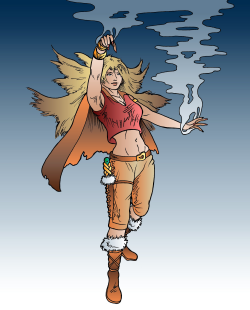
 I wrote this for anyone who is thinking of pursuing art as a career, but the concept of diversifying your skills is true not only in art or writing, but in any profession. The more skills you have—the more opportunities you'll have.
I wrote this for anyone who is thinking of pursuing art as a career, but the concept of diversifying your skills is true not only in art or writing, but in any profession. The more skills you have—the more opportunities you'll have.
When I was a young kid, my parents encouraged me to continue to work on my art. They also made it very clear that I would never make money as an artist. Fortunately, I've always been a bit hardheaded.
Though I've held a variety of jobs that had nothing to do with art, the majority of my employment has included art in one form or another. I've been a freelance artist and a screen-printing artist. I've painted pictures on the side of handmade baskets, and I've drawn caricatures of people at a water theme park. And I've worked with various forms of computer graphics.
There are artists who make a good living just creating art and selling it. However, to be successful you have to be skilled, talented and a bit lucky. The world of art is very competitive. Even though it is possible you could make a career doing nothing but the art you enjoy, the odds are you'll need to direct some of your creativity toward your skill set to be successful.
Diversify. Learn as many art skills as you can. Whatever you find interesting, research it and, if possible, develop skills for it. Drawing, painting, sculpting—these are all good skills to work on. Computers are wonderful tools for artists. Learning to use paint programs, create 3D models and renderings, or pretty much anything digital can be a great plus to your set of skills as an artist. Spend as much time as you can building your skills in various areas of art as you can. The more skills you have—and the better you are with them—the more opportunities you'll have to find employment as an artist.
Also, the more diversified you are in your subject matter, the better off you'll be. If all you draw are dragons and fairies, you might find it difficult to sell your art. However, if you draw horses, you can now include horses, unicorns and Pegasi (and any modifications for sci-fi or fantasy you wish to create). Add people and landscapes. Now you can create very detailed fantasy and sci-fi art. You've also opened up the possibility of being asked to create nature art.
The more things you can draw, the better your art will be. With a better understanding of the things you draw, you'll also improve on the details in your art. By expanding what you create and the mediums you use to create them, you improve your appeal to potential buyers and employers.
Remember, you should never abandon your art if you enjoy it. However, treat it as a skill among many to pull from so you have options when you enter the workforce. Those computer skills might be very attractive to an employer. And no matter what work you may be applying for, bring your portfolio (or at least have it nearby and ready to show) and always make it clear on your application and resume that you are an artist. You might be surprised how often art skills will help you find work.
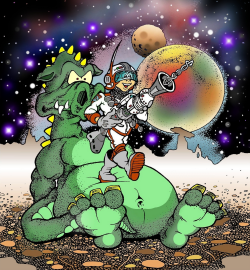
As a teen ready for college I applied for a summer job in shipping at a screen-printing shop. I brought my portfolio with me. They hired someone else for the shipping job—I was hired as their new artist.
When I applied to my current job, I was applying to be a programmer. I got the job, but I have been utilized as the creative element in our IT department. I've worked on everything from magazine ads to web design. I create the proposals we bring to companies, and I work on the images that they use on-air and in their publications. Basically, if it needs to be drawn or digitally worked on, I get to play with it.
Back to the screen-printing artist job: the second day of work there, I had the screen printer teach me to burn the screens, set up the machines, and how to print the shirts. I learned everything I could about his work. That allowed me to do a better job creating the art and color separations for him to work with and also gave me skills I could use later in my life.
Of course, it is possible you might find a job you really like that pays well but has nothing to do with art. There's no crime in that. You can always continue to do your art for fun. I enjoy creating comic book, fantasy and sci-fi art at home. I also have enjoyed using words as my medium and writing about the art I've been creating for years. My art and writing skills have both served me well at work.
Always be open to learning new things. The more you know, the more control you'll have over your future. Diversity equals opportunity. But you'll only be as successful as the quality of your skills. Spend as much time as you can with your studies and developing your art skills. And remember—it's only a skill if you're good at it.
Mr. Illustrator
Mood Music
 I enjoy any excuse to talk about books and music, and for me they complement each other. Some people need silence to write: I'm not one of those. Granted I'll take silence over certain background sounds—like TV shows when the family is watching something—I'd rather have mood music. And thanks to my earbuds, I can cancel out those background noises with what I need to hear. Yes, need. I crave music!
I enjoy any excuse to talk about books and music, and for me they complement each other. Some people need silence to write: I'm not one of those. Granted I'll take silence over certain background sounds—like TV shows when the family is watching something—I'd rather have mood music. And thanks to my earbuds, I can cancel out those background noises with what I need to hear. Yes, need. I crave music!
When starting a new story, I begin with characters, usually just one. The others blossom from the central person. Those characters tell me where they live (setting) and I get an inkling of a plot idea, but to go any further I need music. Before I write a word of the story, I begin a "Mood Music" playlist in my iTunes account. It might only have half a dozen songs when I start writing, but as I get to know the characters and plot, that file grows. As I get further along in the story, I might drop songs that don't quite fit the mood like I expected them to, but I'm always adding to it—which is easy to do in my eclectic, ever-growing collection.
 Right now, I'm working on a Gothic read (a little bit Southern, a little bit horror) for mature readers. My Mood Music playlist has over a day and a half of songs to it. Yes, that means I could write for over twenty-four hours straight and never hear the same song twice. It has a mix of genres, but is predominately power metal and classical. Using musical themes to fit the mood I want to portray in a story—or even a certain scene—helps me get into the proper mind-set and opens me to emotions that the characters are going through. It could be seen as a way to method acting, because music is one of the easiest ways to stir feelings in the right direction.
Right now, I'm working on a Gothic read (a little bit Southern, a little bit horror) for mature readers. My Mood Music playlist has over a day and a half of songs to it. Yes, that means I could write for over twenty-four hours straight and never hear the same song twice. It has a mix of genres, but is predominately power metal and classical. Using musical themes to fit the mood I want to portray in a story—or even a certain scene—helps me get into the proper mind-set and opens me to emotions that the characters are going through. It could be seen as a way to method acting, because music is one of the easiest ways to stir feelings in the right direction.
While I can write to any type of music, I can only edit to instrumentals. Hearing other people's words gets in the way of seeing where my words stand. When I'm finished with edits, I take my mood music list and narrow it down into a soundtrack for each novel, which is a chronological expression of the story through music. Check out my listings for
Corroded
and
Fortitude.
How do you use music to fuel your writing time? Even if you can't work with music, try listening to something that sets the mood for fifteen minutes or more before you start writing. I'd love to hear your results.
Word Rocker
Don't let your fortitude get corroded.
Corroded (https://carriedalby.com/2016/04/12/corroded-in-the-wild/)
Fortitude (https://carriedalby.com/2016/01/28/the-music-of-fortitude/)
|
Serious writing shouldn't be a joke
 I received this joke in an e-mail: I received this joke in an e-mail:
A wife asked her husband, "Could you please go shopping for me and buy one carton of milk, and if they have eggs, get 6." A short time later the husband came back with 6 cartons of milk. The wife asked him, "Why on earth did you buy 6 cartons of milk?" He replied, "They had eggs."
This made me think of something that happened with my sister when she was a young teen.
My mother asked my sister to make some hot chocolate. Her instructions were—pour the milk into a plastic measuring pitcher and then put it in a pot on the stove and turn on the heat. A short while later my mother found the pitcher in the pot—full of milk—melted nearly in half.
This story is a source of much humor in my family. But it also brings up a point. We need to think about how we phrase what we write.
How often have you read something and started to stumble over what was written, but couldn't really tell what was wrong with it? There's a fair chance the writing, though it might be properly written, is written unclearly.
I'm not saying the writing has to be in short clear sentences. A long sentence with lots of punctuation can easily be written clearly.
Just like the shortest distance between two points is a straight line, the best way to not confuse someone is to keep your thoughts separate. Using the above joke as an example, keep your eggs from your milk. The more subjects you put in a sentence the more confusing it is likely to be. The more times you change directions in a paragraph, more likely you are to slow the reader's progress through your story.
Remember to keep the clutter out of your writing and maybe it won't wind up being a joke.
Mr. Illustrator
|
|
|
|
